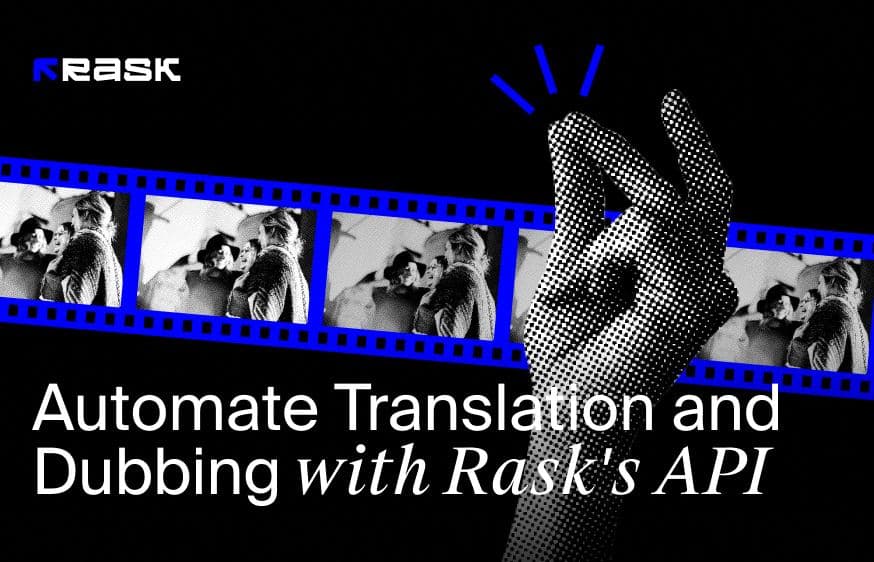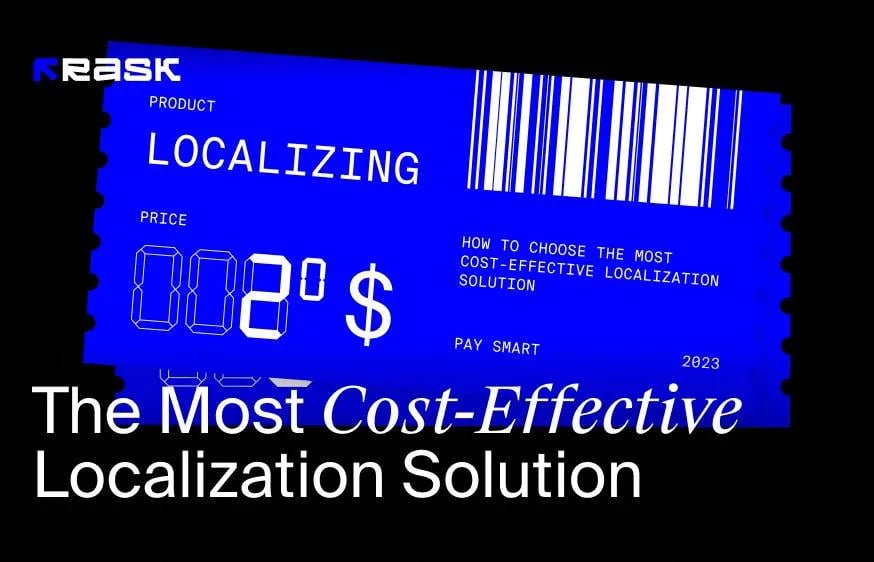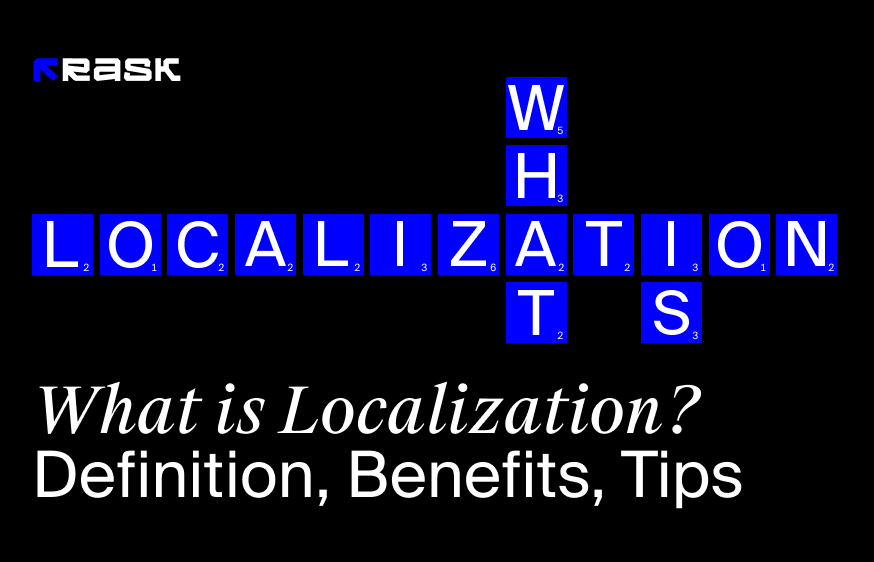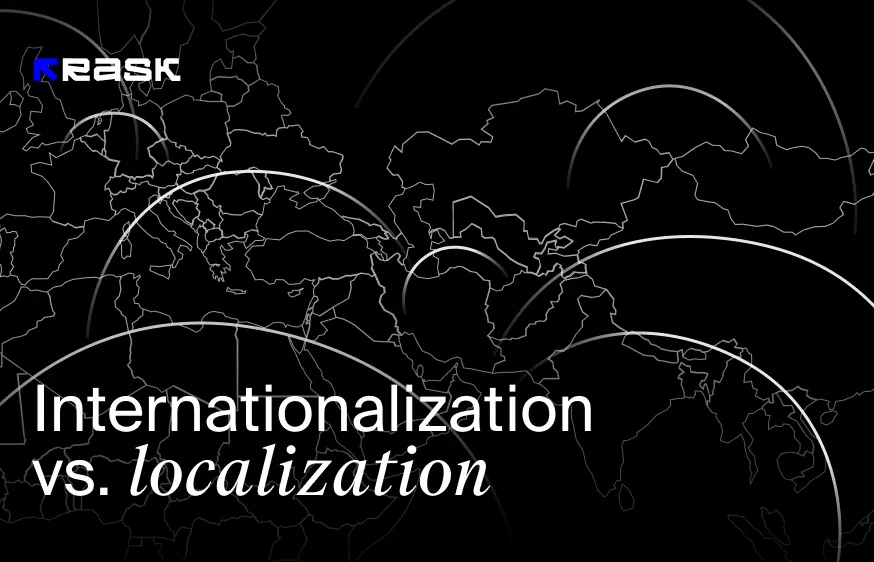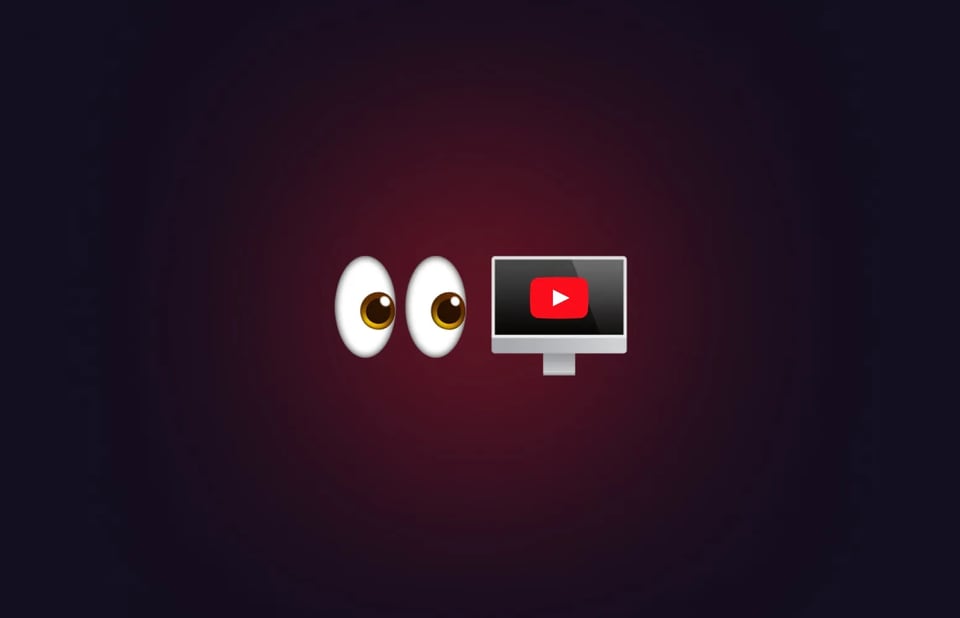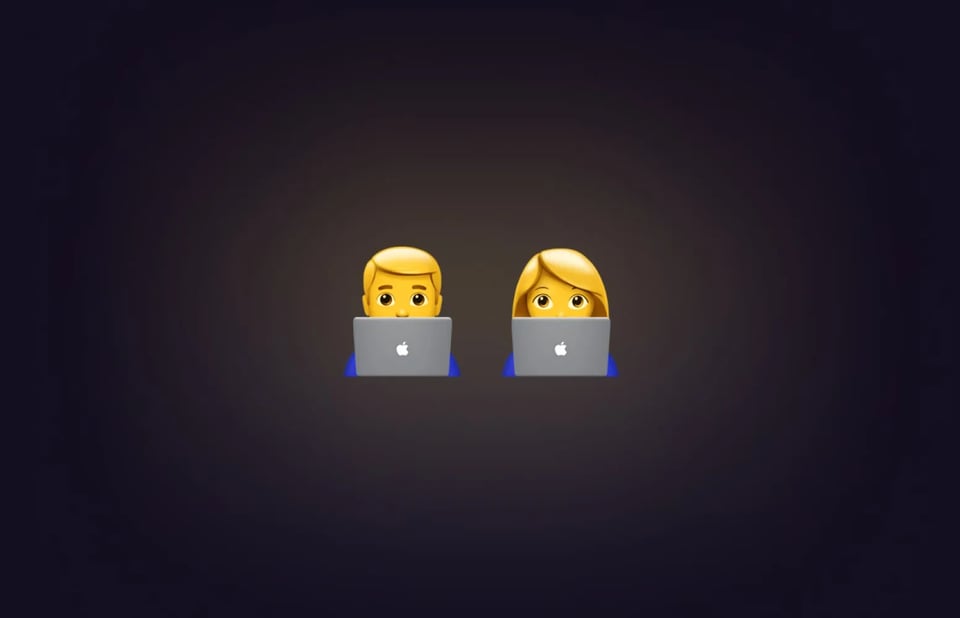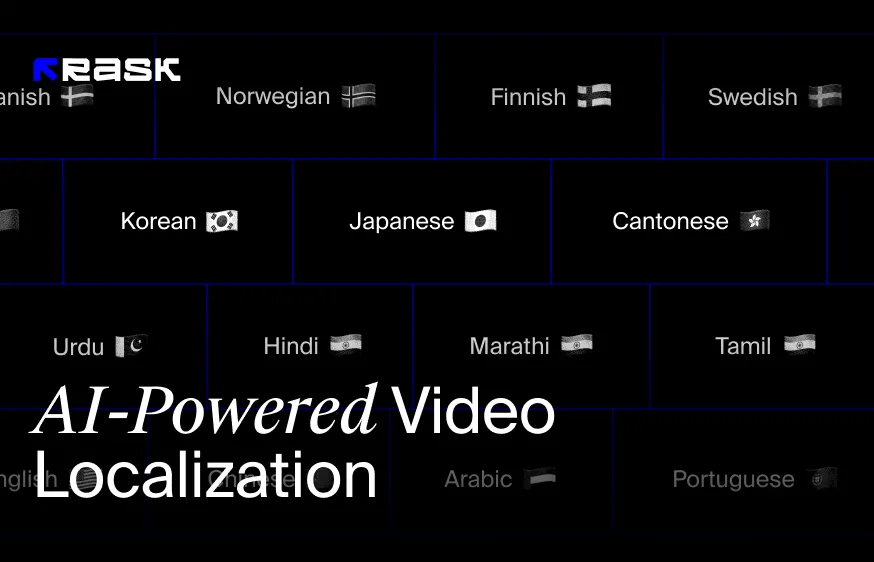Rompere le barriere: Il ruolo della localizzazione dei giochi nel successo globale
Cosa c'è dentro
In qualità di sviluppatori di giochi, vi chiederete come ottimizzare la vostra attività e penetrare in nuovi mercati nel 2023. Cercando informazioni, probabilmente vi sarete imbattuti in termini come servizi di localizzazione "professionali", servizi di traduzione letterale, servizi di sottotitolazione "professionali", ecc.
Ma avete mai trovato una risposta al suo significato? Perché questi servizi sono così popolari nel mondo digitale di oggi? Come raggiungere il successo nell'industria globale dei videogiochi con la localizzazione dei giochi? Avete appena trovato il vostro jolly, quindi andiamo più a fondo.
La popolarità dei servizi di localizzazione non è legata solo ai videogiochi, ma riguarda le aziende di una vasta gamma di settori. Tuttavia, in questa sede ci concentreremo sui giochi. In poche parole, la localizzazione è un'opzione perfetta per qualsiasi azienda di videogiochi che voglia attirare un pubblico globale.
Che cos'è la localizzazione dei videogiochi?
La localizzazione dei videogiochi è molto più di una semplice traduzione. Si tratta del processo di adattamento del gioco a un nuovo mercato videoludico. Questo processo prevede molte fasi che prendono il gioco originale e lo modificano fino a quando il videogioco e il suo pubblico non si adattano perfettamente.
Come nel marketing tradizionale, alcune cose sono migliori, altre no. Lo stesso accade con la localizzazione: culture e mercati diversi hanno gusti, valori, sfumature culturali, religioni e, naturalmente, lingue diverse. Per creare la migliore immersione del giocatore, è necessario adattare il prodotto a tutte le differenze dei mercati. L'importanza dei giochi per accedere al mercato globale
Come qualsiasi altra attività commerciale, anche le aziende di videogiochi trarrebbero vantaggio dall'accesso a nuovi segmenti di clientela, dall'ampliamento del proprio pubblico e dalla costruzione di solide relazioni con i clienti parlando la loro lingua madre.
Supponiamo che gestisca un'attività a Londra. Cosa vi impedisce di rendere disponibile il vostro gioco in Germania, Spagna o Grecia? La risposta breve è: le barriere linguistiche, i problemi di traduzione e la mancanza di comprensione della localizzazione. Sbarazzarsi di questo fattore chiave vi aiuterà ad andare avanti due volte più velocemente.
Vantaggi della localizzazione dei videogiochi
1. Aumentare le vendite
I videogiochi sono il modo più popolare e impressionante per mantenere il pubblico impegnato e divertito. È difficile trovare una persona che non abbia mai giocato o che non voglia giocare a un grande gioco quando il tempo lo permette. Se il vostro prodotto non è localizzato, pensate che le persone saranno in grado di trovarlo o di investire tempo per capire la lingua madre del gioco solo per giocare?
La risposta è no.
Se volete rendere il vostro gioco comprensibile e facile da giocare per i vostri clienti, la localizzazione è un must. Più pubblico attirerete con la localizzazione del gioco, più alte saranno le vendite. Non c'è quindi bisogno di perdere tempo.
2. Personalizzare i giochi
La localizzazione dei giochi fa anche sentire i clienti più importanti. Questo effetto si ottiene perché il gioco viene adattato alle esigenze specifiche di un nuovo pubblico. La localizzazione completa del gioco consente di soddisfare i clienti esistenti e quelli nuovi ancora prima che inizino a giocare.
La personalizzazione è oggi un fattore cruciale per il successo aziendale, poiché è l'unico modo per le aziende di distinguersi dalla concorrenza. Le aziende che conoscono il proprio pubblico di riferimento tendono ad avere il pubblico più fedele e le vendite più elevate attraverso i diversi canali di marketing. Siamo onesti: a chi non piace la personalizzazione, soprattutto quando si tratta del proprio gioco preferito?
3. Migliori classifiche dell'App Store
Nel negozio di applicazioni per dispositivi mobili di ogni Paese è presente un'elevata quantità di giochi. Ma non tutti i giochi sono classificati a 5 stelle (a dire il vero, non tutti hanno nemmeno tre stelle). Tuttavia, quelli che sono riusciti a ottenere le cinque stelle tendono ad avere una cosa in comune: la localizzazione. Le statistiche mostrano che i videogiochi in versione inglese raggiungono solo il 27% del mercato globale dei giochi.
4. Aumento della fiducia
La localizzazione dei videogiochi dimostra che la vostra azienda rispetta le altre culture attraverso il processo di traduzione del sito web e la localizzazione degli elementi del gioco. Secondo la ricerca CSA, il 60% dei non madrelingua inglesi acquista raramente o mai giochi non localizzati. La stessa fonte riporta che il 64% degli acquirenti dichiara di apprezzare i contenuti localizzati dei siti web. L'adattamento culturale vi permette di guadagnare la fiducia e la fedeltà dei clienti più che con sconti o campagne di marketing.
Quando il vostro gioco e voi, come azienda, riuscite a guadagnare fiducia, potete anche aumentare gli indicatori chiave di prestazione (KPI) per ottenere un notevole incremento. I KPI vengono utilizzati per stimare e misurare le prestazioni complessive di un prodotto o di un'azienda, le sue attività, i suoi processi e l'andamento di progetti specifici.
5. Maggiore coerenza del marchio
Localizzare i giochi significa localizzare il vostro sito web, le campagne di marketing e qualsiasi altro elemento aziendale. Questo vi permette di avere il pieno controllo sul messaggio che volete trasmettere al vostro nuovo pubblico di riferimento, offrendo un marchio e un'esperienza di gioco coerenti in tutti i mercati.
La localizzazione garantisce che il messaggio del marchio sia il più accurato e pertinente possibile e che sia in linea con gli obiettivi aziendali. La localizzazione va anche oltre, garantendo che tutti i contenuti del videogioco non solo siano tradotti, ma coprano anche tutti gli elementi culturali e le preferenze di ogni nuova regione, organizzando la coerenza del marchio e migliorandone l'immagine.
6. Migliore segmentazione
Le aziende possono ora utilizzare i servizi di traduzione e gli strumenti di localizzazione per facilitare la condivisione di messaggi personalizzati con gli spettatori dei diversi mercati globali. La possibilità di generare rapidamente un testo tradotto e di controllare il messaggio del marchio migliora anche la segmentazione dei mercati, consentendo di parlare direttamente al pubblico locale per un migliore targeting.
La localizzazione dei giochi è la stessa cosa della traduzione?
La risposta breve è no. Si può semplicemente tradurre il testo e la velocità del gioco con un livello di sofisticazione tale da riconoscere tutti gli idiomi, i termini e i riferimenti culturali. Oppure si può utilizzare la traduzione di un videogioco parola per parola come compito multiforme. La localizzazione va oltre la semplice traduzione. Ci sono tre termini che spesso vengono confusi quando si parla di penetrare in un nuovo mercato di videogiochi. Esaminiamo più da vicino le loro differenze per rendere il vostro gioco disponibile per l'uso globale.
Traduzione
La traduzione di videogiochi è semplicemente un processo di traduzione del mondo scritto e parlato nella lingua di destinazione. Sebbene sia una fase cruciale per rendere il vostro prodotto disponibile per il mercato internazionale, la traduzione da sola non porterà ai risultati attesi. È necessario assumere un team esperto di madrelingua, oppure si può ricorrere a soluzioni accurate e convenienti come Rask AI, che offre oltre 60 lingue per tradurre il vostro gioco.
Internalizzazione
L'internazionalizzazione prepara il gioco alla localizzazione, rendendo l'infrastruttura tecnica del prodotto adattabile a qualsiasi mercato.
È una fase tecnica della localizzazione che viene eseguita dal team di sviluppo. L'internazionalizzazione serve a risolvere problemi come la codifica dei caratteri del testo e a garantire che il codice sorgente funzioni come previsto in diverse località. Risolve anche i problemi relativi ai formati di data e ora, all'interfaccia utente e ad altri elementi simili.
Anche se alcune aziende saltano questa fase, l'internazionalizzazione è fondamentale per il successo della localizzazione. Inoltre, accelera il processo e rende la localizzazione più efficiente. La sua importanza è ancora maggiore quando si localizzano giochi di grandi dimensioni o si scelgono più località contemporaneamente.
Elementi chiave dei videogiochi che la localizzazione comporta
1. Elementi della storia nel gioco
Un gioco coinvolge e mantiene vivo l'interesse degli utenti. È qui che entra in gioco la localizzazione degli elementi della storia. Tutti gli elementi della storia, compresi i nomi dei personaggi, dei luoghi e delle armi, devono essere localizzati per offrire al giocatore un'esperienza il più possibile accurata e personalizzata. I nomi degli elementi che semplicemente "non si adattano" alla sceneggiatura possono costringere i vostri potenziali giocatori ad abbandonare il sito web o l'applicazione in pochi minuti.
Ad esempio, se la storia del gioco si svolge in Spagna, i nomi delle strade e dei negozi dovrebbero essere tratti dalla Spagna. Ci sono altre sfumature culturali, come il fatto che alcuni nomi che sono femminili nella nostra lingua e cultura potrebbero essere maschili in altre.
Il vostro partner per la localizzazione dei videogiochi (se ne avete uno) può aiutarvi ad analizzare tutti gli elementi del vostro gioco, in modo da capire cosa deve essere localizzato, dal nome e l'aspetto di ogni personaggio e oggetto ai nomi delle strade e ai punti della trama. In questo modo si può garantire che il gioco sia facile da seguire e da giocare.
2. Elementi tecnici
La localizzazione di elementi tecnici come orari, date e unità di misura viene spesso saltata a causa della sua complessità. Tuttavia, sono una parte cruciale dello sviluppo di un'esperienza di gioco coinvolgente e fluida. In questo caso, si può chiedere l'aiuto di un professionista, poiché si tratta di elementi tecnici che richiedono conoscenze nel settore.
Ad esempio, l'adattamento di uno spazio di testo nell'interfaccia utente. Si tratta di un aspetto cruciale, poiché questo spazio è spesso limitato e può diventare un problema quando si traduce il testo di un gioco utilizzando un alfabeto diverso, come quello tedesco.
3. Elementi di marketing
Anche le campagne di marketing devono essere localizzate. Anche se ci si può concentrare solo sulla creazione di account di social media pertinenti, i risultati migliori si ottengono quando i team di marketing investono tempo nella creazione di una serie di materiali di marketing per massimizzare l'appeal e il successo commerciale dei loro giochi a livello globale.
La localizzazione degli elementi di marketing non riguarda solo le pubblicità e il design grafico, anche se in alcuni casi può essere sufficiente. Nei casi più estremi, la strategia di localizzazione può comportare una strategia di monetizzazione completamente nuova, poiché i giocatori delle diverse regioni hanno abitudini uniche quando effettuano acquisti di gioco.
Processo di localizzazione dei videogiochi | Fasi
Fase 1: scegliere nuovi mercati target
Il primo passo è sempre quello di scegliere il mercato di destinazione per il quale si desidera che il prodotto sia disponibile. Non scegliete più lingue che si dice siano le più popolari. Anche se potete scegliere una o due delle lingue più popolari, vi consigliamo sempre di controllare a fondo l'intero elenco dei mercati potenziali, di eseguire un'analisi con il vostro gioco e di scegliere quelle che possono contribuire al vostro successo a lungo termine.
Ad esempio, i primi 10 Paesi per fatturato di gioco sono:
- Cina;
- STATI UNITI;
- Giappone
- Corea del Sud;
- Germania
- Regno Unito;
- Francia;
- Canada;
- Italia;
- Spagna.
È bene considerare anche i Paesi con il maggior numero di utenti di smartphone e laptop. Si tratta di persone che si desidera attrarre, poiché gli utenti di smartphone trascorrono la maggior parte della giornata con il telefono in mano.
Potete anche controllare l'analisi dei download del gioco e vedere quali sono i Paesi che scaricano di più il vostro gioco: un modo pratico e sicuro per scoprire chi volete attirare.
Fase 2: decidere se è necessario aggiornare i contenuti prima di cominciare
La maggior parte dei contenuti scaricabili dei giochi include elementi come messaggi vocali, immagini, istruzioni, stringhe e descrizioni del gioco e dei personaggi. Sebbene sia possibile lasciare alcuni elementi indipendentemente dal nuovo mercato (come le immagini neutre), alcuni elementi dovrebbero essere coinvolti nel kit di localizzazione ed essere adattati alla nuova cultura di destinazione.
Ad esempio, alcuni Paesi preferiscono le immagini realistiche ai disegni dei cartoni animati nei giochi, quindi assicuratevi che tutti gli elementi del gioco producano effetti culturali positivi sui vostri mercati di riferimento. I nomi dei personaggi devono far sentire i giocatori vicini alla loro cultura. Per esempio, un personaggio del gioco chiamato "John" è più appropriato per il mercato statunitense rispetto a un nome come "Muhamed", più adatto al mercato arabo.
Passo 3: localizzare il codice
Come abbiamo detto, la localizzazione è un processo completo. Pertanto, è necessario localizzare anche il codice del gioco. Anche se è sempre meglio rendere il codice compatibile, in alcuni casi le aziende devono estendere il processo per ottenere i risultati attesi in termini di localizzazione tecnica.
Si consiglia di seguire gli standard di localizzazione della piattaforma per cui il gioco è stato progettato. Supponiamo che il vostro videogioco sia sviluppato specificamente per gli utenti Android: in questo caso, dovrete seguire e rispettare gli standard di localizzazione Android dal punto di vista della codifica.
Lo sviluppo di un codice stabile e compatibile con la localizzazione garantirà che tutti i contenuti del gioco siano completamente integrati con il sistema di gestione delle traduzioni, in modo da non rendere la localizzazione due volte più lunga.
Fase 4: Preparare un brief per un team di localizzazione
La localizzazione di un videogioco può essere una sfida che richiede molto tempo. Inoltre, la mancanza di conoscenza e di comprensione della strategia di localizzazione potrebbe portare a costosi errori da risolvere dopo il rilascio. Nessuno vuole questo, quindi la maggior parte degli sviluppatori di videogiochi preferisce assumere team di localizzazione invece di crearne uno da zero o assumere freelance per ogni compito. Il team di localizzazione può iniziare solo con una breve descrizione di ciò che si vuole ottenere alla fine del processo di sviluppo e localizzazione.
Un brief ben strutturato e pulito comprende di solito i seguenti elementi:
- Lunghezza delle corde;
- Il tono della lingua;
- Come gestire i nomi dei personaggi;
- Come gestire i formati delle date;
- Qualsiasi altra istruzione relativa alla lingua.
Fase 5: utilizzare strumenti basati sull'intelligenza artificiale
Che si collabori o meno con un'agenzia di traduzione o localizzazione, la parte fondamentale del kit di localizzazione può comunque essere realizzata utilizzando strumenti basati sull'intelligenza artificiale per ottenere un buon rapporto costi-benefici e una maggiore precisione. Ad esempio, è possibile utilizzare uno dei principali strumenti di localizzazione: Rask AI. Questo strumento consente alle aziende che sviluppano giochi di localizzare facilmente i loro prodotti in oltre 60 lingue in base alle loro preferenze. Rask offre anche una vasta gamma di strumenti utili per un processo di localizzazione rapido e senza interruzioni. Questi includono:
Gli strumenti di intelligenza artificiale vi aiuteranno a risparmiare il tempo sprecato per le assunzioni, i test di qualità e il rilascio di giochi localizzati.
Fase 6: Prova del gioco localizzato
L'ultima fase consiste nel testare il gioco. Poiché nel processo di localizzazione dei videogiochi sono coinvolti molti team, è meglio testare la copia localizzata del gioco prima di rilasciarla sul nuovo mercato. Potete chiedere al vostro team di localizzazione di eseguire la fase di test o assumere uno specialista che vi aiuti a verificare se ogni elemento del gioco localizzato funziona come dovrebbe.
Il test funzionale è responsabile della verifica del corretto funzionamento dei pulsanti e dei collegamenti diretti alle parti necessarie del prodotto e ad altre funzioni. Il test linguistico è responsabile della revisione della lingua di destinazione. Controlla la grammatica, l'ortografia, la punteggiatura e gli errori di traduzione.
Il test culturale è responsabile della revisione delle immagini, della grafica e di tutti gli altri elementi visivi del prodotto per garantire che coprano tutte le sfumature culturali.
Fase 7: Monitoraggio dei risultati dopo il rilascio
La localizzazione dei videogiochi deve essere monitorata come qualsiasi altra campagna di marketing. Ciò significa che dovrete anche raccogliere i feedback degli utenti, in modo da sapere quanto sia stato efficace il processo di localizzazione del gioco. Una volta raccolto il feedback, tornate sul prodotto e risolvete i problemi che si presentano nelle diverse località, dimostrando ai nuovi clienti che ci tenete.
Quanto tempo richiede il processo di localizzazione?
La risposta dipende da molti fattori. Tuttavia, la localizzazione di un gioco normale richiede solitamente dai 3 ai 6 mesi. Ciò comporta l'intero processo, dalla preparazione dei contenuti al rilascio del prodotto. Inoltre, anche il numero di lingue scelte influisce sul tempo necessario per la localizzazione. Pertanto, è sempre meglio avere un piano stabilito con tappe a breve e a lungo termine prima di iniziare il processo. Oppure potete semplicemente scegliere la versione più veloce: la localizzazione di box e documentazione.
A titolo di esempio, si può considerare quante settimane saranno necessarie per localizzare solo i contenuti. Oppure quante settimane ci vorranno per i dialoghi di gioco e per generare i doppiaggi (l'intelligenza artificiale diRask genererà i doppiaggi e tradurrà i vostri contenuti in pochi minuti). Quindi non sono necessari doppiatori.
Per quali lingue e regioni si dovrebbero localizzare i videogiochi?
Abbiamo già menzionato alcune delle lingue più popolari per la localizzazione. Tuttavia, l'inglese rimane la lingua franca della localizzazione nel settore dei videogiochi. Pertanto, i diversi dialetti inglesi dovrebbero sempre essere il punto di partenza e rimanere la priorità dell'elenco.
L'idea migliore per la localizzazione di videogiochi (o la localizzazione parziale) è quella di iniziare con le cosiddette lingue "FIGS". FIGS è l'abbreviazione di francese, italiano, tedesco e spagnolo europeo. Queste lingue sono fondamentali perché rappresentano Paesi con mercati di gioco significativi e ogni lingua originale ha una portata maggiore al di fuori dei propri confini.
Ad esempio, se decidete di localizzare il vostro prodotto in francese, avrete accesso ai giocatori francesi ma anche a quelli che vivono in Belgio, Svizzera, Monaco e in alcune zone del Canada. E tutti questi sono mercati di gioco di alto valore. Allo stesso modo, una localizzazione in tedesco garantisce l'accesso a Germania, Austria, Svizzera e Lussemburgo.
Il mercato di gioco più alto è quello del cinese mandarino, ma non è facile trovare un madrelingua. La grande notizia è che Rask AI offre tutte queste lingue, compreso il cinese mandarino e molto altro.
Suggerimenti e buone pratiche per la localizzazione dei giochi
Iniziare a pianificare per tempo
Come abbiamo già detto, la localizzazione è un processo vasto e complesso che richiede tempo e denaro. Tuttavia, esiste un modo per accelerare e facilitare il processo. Ciò si ottiene attraverso una pianificazione tempestiva che vi aiuti a evitare problemi specifici della lingua, assicurandovi che il vostro gioco sia in grado di adattarsi alle nuove lingue e dandovi il tempo di creare un glossario. In effetti, più tempo si investe nella pre-pianificazione, più tempo si risparmia durante il processo.
Comunicare chiaramente con il team di localizzazione
Ricordate che il team di localizzazione non conosce il gioco come voi, quindi una comunicazione chiara e frequente è sempre la chiave del successo. La mancanza di comunicazione di solito porta a un superamento dei costi e al mancato rispetto delle scadenze. Ad esempio, il team potrebbe non comprendere appieno un elemento o un personaggio chiave del gioco e quindi localizzarlo in modo improprio. Lo vorreste? Noi pensiamo di no.
Considerare i requisiti linguistici specifici
Questo punto è fondamentale per le aziende che intendono localizzare il gioco in una lingua che si legge da destra a sinistra. Tra queste vi sono l'arabo e l'ebraico, mentre altre lingue asiatiche dovrebbero essere posizionate dal basso verso l'alto, soprattutto quando si tratta delle prime forme linguistiche. Per questo motivo è fondamentale essere proattivi per quanto riguarda le esigenze specifiche di ogni nuova località.
Rendere il testo facilmente estraibile dal codice
Abbiamo già parlato della necessità di approfondire i dettagli tecnici durante la localizzazione per ottenere il successo. Per questo motivo è necessario rendere disponibile il codice sorgente per facilitare l'accesso, la traduzione e la reimportazione degli elementi linguistici nel gioco. Ad esempio, si può scegliere il formato XML, il più diffuso per la creazione di file di risorse. Oppure si possono scegliere alternative come JSON e YAML. Dando a ogni stringa un proprio ID, è possibile semplificare la localizzazione e ridurre i costi.
Conclusione
La localizzazione dei giochi è un processo difficile e lungo. Tuttavia, è un processo cruciale quando si vuole competere nel settore dei giochi. È possibile accelerare il processo e ridurre i costi utilizzando strumenti di intelligenza artificiale come Rask AI o assumendo un team esperto. In generale, siete voi a poter trarre il massimo dalla localizzazione seguendo i passaggi cruciali e implementando i suggerimenti per aprire nuove opportunità di guadagno con la localizzazione dei giochi nel 2023.


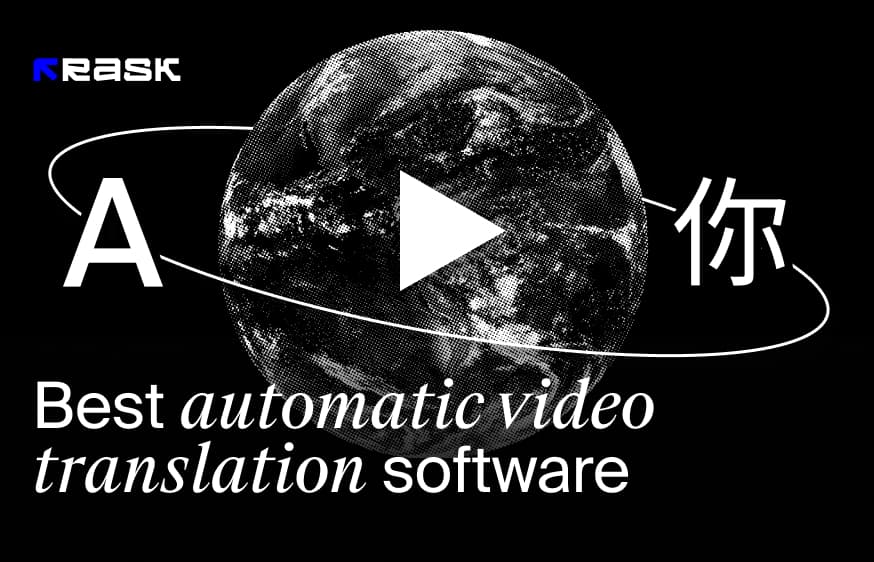
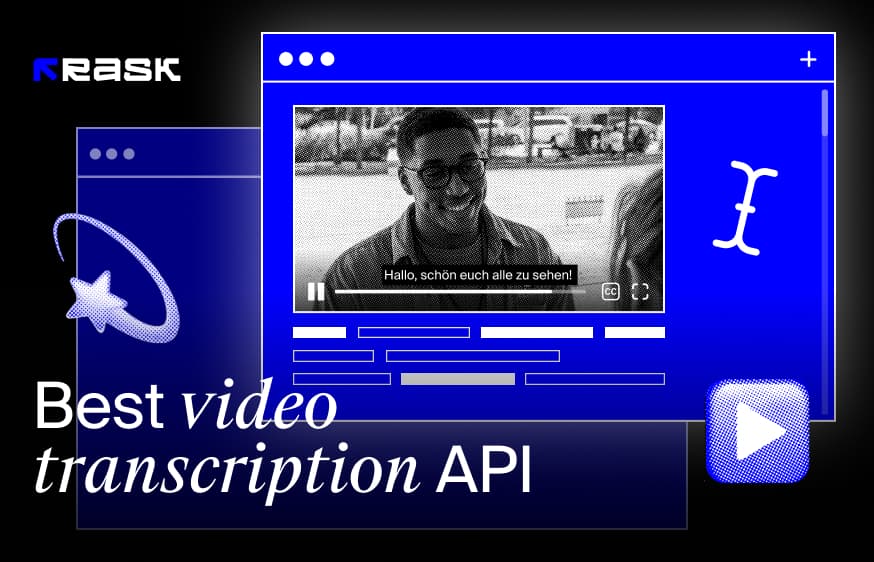

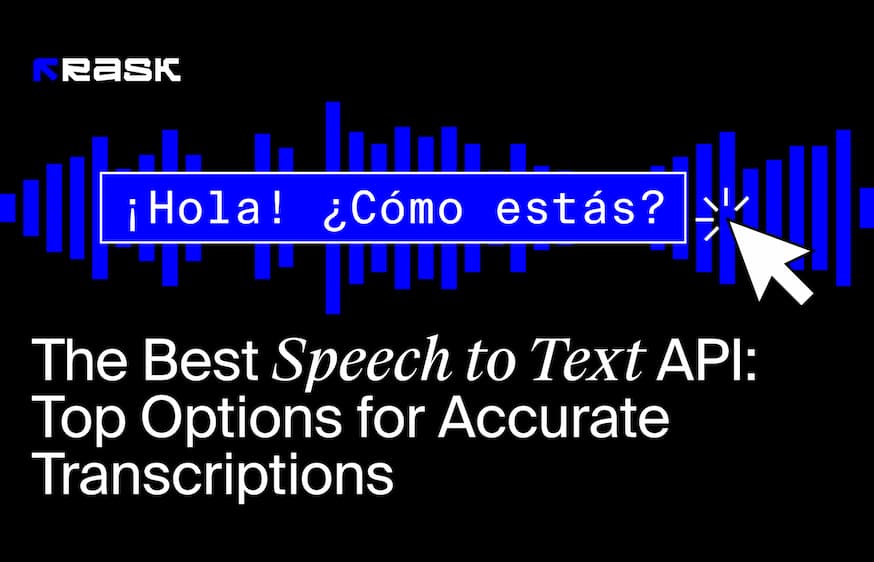

.jpg)
.webp)

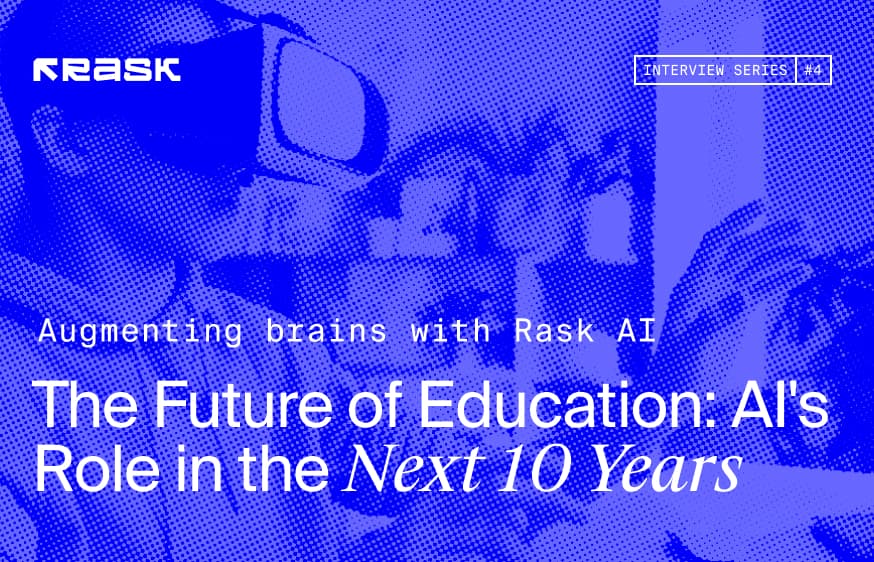
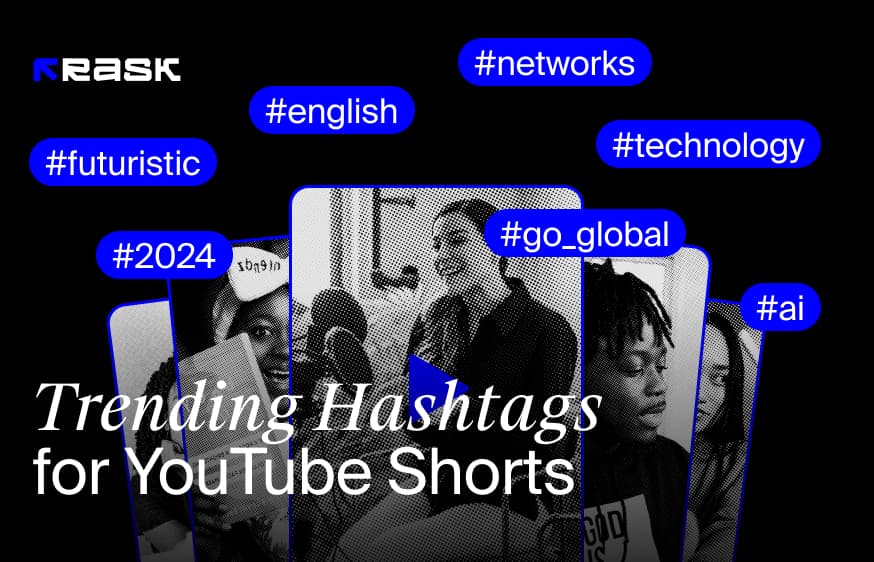
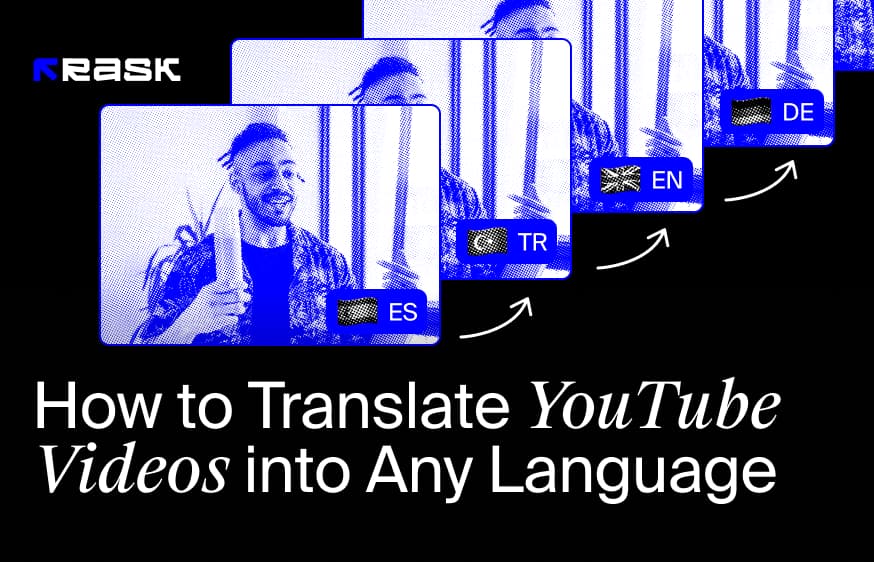
![8 Migliori app di traduzione video per i creatori di contenuti [del 2024].](https://rask.ai/cdn-cgi/image/width=960,format=auto,fit=scale-down/https://cdn.prod.website-files.com/63d41bc99674c403e4a7cef7/6668a3dcd3175bd1d1c73c81_Best%20video%20translator%20apps%20cover.webp)
![Il miglior software di doppiaggio AI per la localizzazione dei video [del 2024].](https://rask.ai/cdn-cgi/image/width=960,format=auto,fit=scale-down/https://cdn.prod.website-files.com/63d41bc99674c403e4a7cef7/66685014f68137eb05c89c16_Cover.webp)

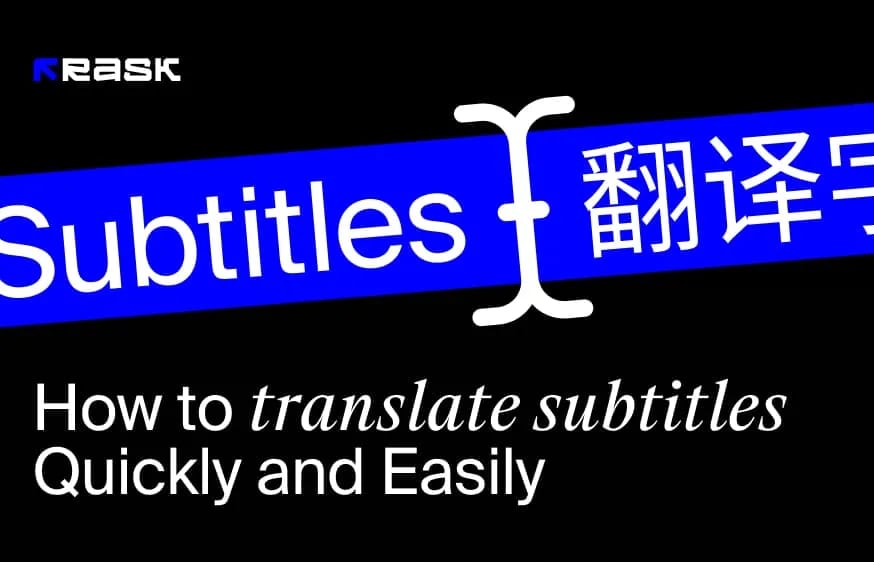
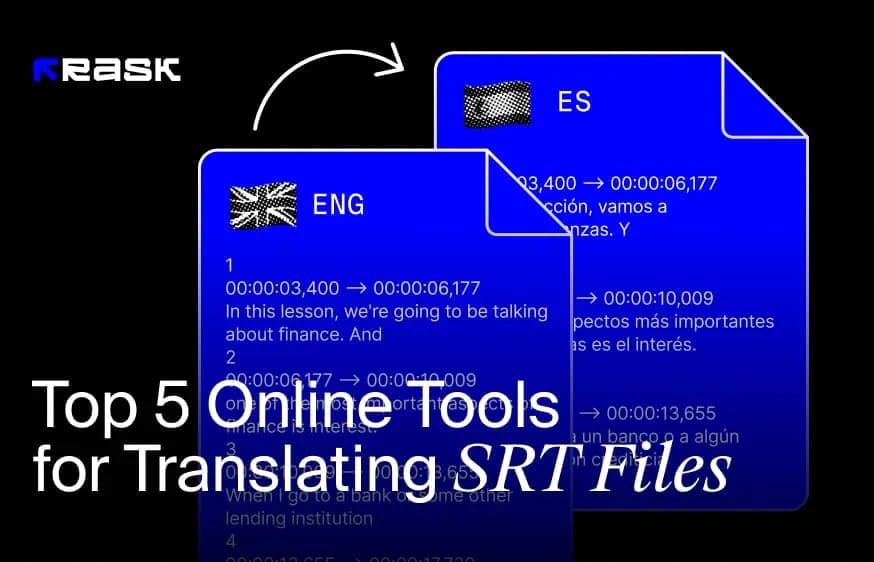

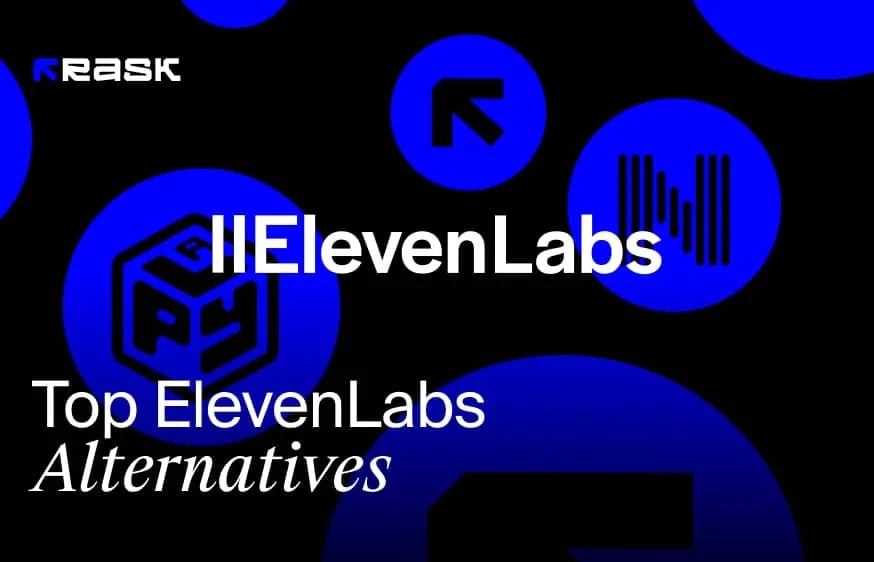
.webp)
